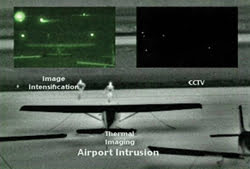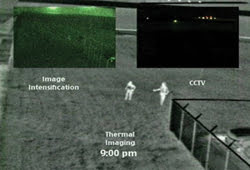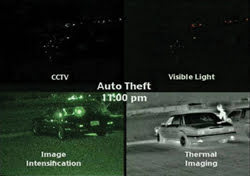The differences among the three main night-vision camera classifications -- near-IR, image intensification and thermal imaging -- are significant.
Stanley Kummer, Raytheon Infrared
As media saturation spreads in the Western world, it is almost impossible to go anywhere without seeing some kind of a camera. This increase in camera use is highly evident in the infrared and night-vision market. However, it is important to note that not all cameras are the same; there are some major differences.
Near-IR cameras provide a high-resolution available-light image that looks natural. Used in a number of commercial applications, including home video, near-IR cameras are widely available and relatively inexpensive, with prices ranging from $500 to $2500.
These cameras are sensitive to near-IR wavelengths from approximately 0.7 to 1.2 μm, which is very near to the visible light range that cuts off around 0.7 μm. The near-IR range is used in devices such as remote controls for TVs and DVD players. To be effective in darkness, near-IR cameras use IR illumination. Originally, they used incandescent lights with filters. More recently, brighter LEDs have enabled the devices to be portable and powered by batteries. However, brightness and range are still dependent on the amount of energy consumed, and the attenuation of the light limits the range, even when many LEDs are used.

In this airport security scenario, only the lights in the distance can be seen with CCTV (upper right). With image intensification (upper left), one of the intruders is visible, and with thermal imaging (bottom), both intruders are clear, as are the other details in the hangar.
Reflected energy depends on the color and sheen of objects in the field of view. An individual attempting to evade the camera’s watchful eye can do so by wearing dark colors, avoiding shiny objects, etc. These efforts limit the effectiveness not only of near-IR cameras, but also of image intensifiers. The light used comes from natural sources in the visible range (e.g., moonlight) or from artificial sources such as LEDs in the 0.7- to 1.2-μm range. In addition, these cameras function best within about 75 feet of the object. Because illumination drives the near-IR capabilities, the cameras can consume a lot of battery power, more than is feasible from C or AA batteries.
One of the positives for users of near-IR cameras is that their application is pretty staid and unlikely to undergo rapid change, so their costs will most likely remain stable.
Image intensification
Of the three night-vision camera classifications, image intensification is probably the most well-known. This type of camera produces a green image display, such as those on television news coverage of the war in Iraq. The user sees virtually everything he would see in the daytime. The camera intensifies ambient light and increases the brightness of the image. Intensifier tubes pass incoming light or photons through a photocathode, a thin piece of GaAs glass, discharging electrons. The electrons travel through a microchannel plate that multiplies their quantity greatly. The multiplied electrons strike a phosphor screen, converting once again to photons, now more numerous than before. The phosphor screen then displays the familiar green monochrome image.

With CCTV, nothing is discernible in this scenario (upper right). Image intensification allows you to see only one intruder (upper left), but the thermal imaging camera makes both intruders clearly visible (bottom).
Image intensifiers are typically lightweight because the basic intensifier tube itself has relatively low power. It shows the scene directly from the phosphor, so it is not powering a separate video display. And even though some makers combine LEDs with their intensifier devices, they do not require LEDs for illumination. In addition, because there are no power-draining components, these devices can often operate on AA batteries.
Image intensification requires at least some light to create an image. It functions best when there are high levels of contrast between the objects in the scene, but it is susceptible to the blooming effect, in which a small point source of light blooms and obscures other objects. Consequently, if light levels change rapidly, the image intensifier needs time to adjust because of the amplifying effect of the microchannel plate and tube. Intensifier makers try to throttle down the throughput of the devices when light levels increase, but it takes reaction time just as the human eye does when it is dilated. For instance, if the user is conducting surveillance at night and a car drives into view with its headlights on, the image intensifier will be temporarily blinded.
Most image intensifiers are priced between $200 and $4000. They are not as readily available as near-IR cameras but can be found in specialty shops.
Thermal imagers
In contrast to near-IR and image-intensification cameras, thermal imaging cameras need no visible light to produce an image. They use the long wavelength of the IR spectrum to view a scene. Thermal imaging is achieved in two bands in the mid-IR, approximately 3 to 5 μm and approximately 7 to 14 μm. Although IR cameras do not measure the wavelength per se, they have materials that are sensitive to the incoming radiation in those bands. These materials change temperature and, thus, electrical properties when they absorb the incoming energy. The changing electrical properties can be read out as changes in resistance, capacitance, pyroelectric charge flow or combinations thereof.

With visible light and CCTV, nothing is visible in this image. With image intensification, the car is more apparent, but the light bloom in the background makes the intruder even more difficult to detect. In addition, the image is grainy, with little detail. Using thermal imaging, the thief is clearly visible.
Thermal imaging produces a representation of a scene that is dissimilar to the natural view. Although it is easy to distinguish between objects, some of their visual details can be limited. For instance, it is easy to determine that a car has just been parked (because of the heat from the engine), but it is not possible to tell the color of the car.
Thermal imagers are extremely effective for long distances, identifying objects with a heat signature from a few feet to a few thousand feet away, and they “see” objects through smoke. They range from large units mounted on police vehicles to lightweight handheld products powered by AA batteries.
Thermal imaging cameras have found use in a wide variety of settings, including the military, law enforcement, fire and rescue, transportation, industry and security. They are available commercially, but on a much more limited basis than near-IR or image-intensifying devices. Thermal imagers also tend to be the most expensive of the three classifications, ranging in price from $2000 to $8000 and more.
Meet the author
Stanley Kummer is public safety and industrial markets director for Raytheon Infrared in Dallas.